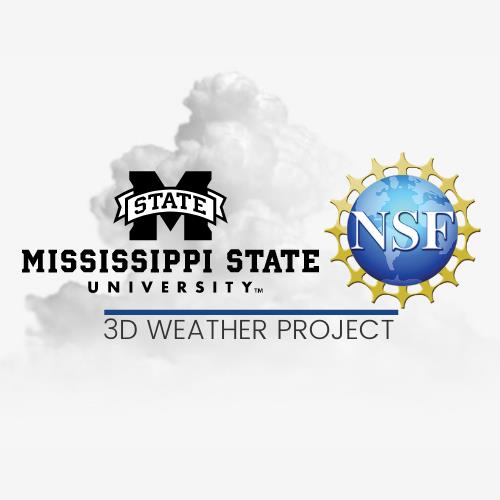3D Weather Data Visualization and Analysis
Powered By: Mississippi State and National Science Foundation
The 3D Weather project seeks to A) improve secondary science education’s capacity to foster scientific and computational knowledge and literacy; B) improve secondary science teachers’ competency to innovate science learning by integrating large scale-atmospheric data and computational thinking and practices into science instruction; and C) make a significant contribution to the body of knowledge regarding how to create STEM education pathways by harnessing the data revolution.
FAQ:
What if my students can't understand all the weather material we learned in the workshop?
The workshop is designed to give teachers an in-depth overview of weather concepts so that they feel confident in their understanding of the topics while teaching. You are not expected to teach all of this material at the same level in your classroom. Our expectations are that teachers should adapt the workshop material to the level of detail that is grade-appropriate for their students.
How long does it take to teach this content in the classroom?
We advise that teachers divide the content they wish to teach into four to six lectures, each between 20-40 minutes long (depending on the age of your students and depth of the material required for a grade-appropriate level of detail. Active-Learning activities (such as mini-projects, group activities, etc) may require additional class time. Generally, we find that teachers are able to implement the workshop content most easily by incorporating one lesson per day over the course of one week. Teaching these lessons less frequently is okay, too, but we recommend completing the content (start to finish) within a timeline no longer than three weeks, with no more than a few days between lessons.
How many spatial and computational thinking skills should I include in my lessons?
It's important to remember that, while we spend a lot of time on weather in the workshop, the problem-solving skills are the primary focus of this research. For this reason, we ask that teachers prioritize including all of the spatial and computational thinking skills over the course of their lessons and learning activities.
Can I use outside resources to supplement my teaching material?
Yes, teachers may find and use any resources they think their students will benefit from. We hope that the material we provide is sufficient, but we understand that some students learn in unique ways. Please feel free to take the resources we provide and modify them to fit your students' needs, and also use any external resources you find helpful. We also encourage you to share these external resources with the 3D Weather team, so we can continually adapt our material for today's students.
How do we integrate the 3D content into other subject areas?
The content of the material is only using weather as the subject matter. You can integrate computational skils into almost any other areas math, science, language arts, and social studies. The real thing you need to focus on is computational thinking skills. 3D can be incorporated into anything spatial computational related.
Do I have to use IDV?
No, IDV is a free open source.
Why are you doing weather?
Weather impacts aspects of everyone’s lives, and through TV, internet, or other media, weather information is always available. Despite this, however, weather data are often poorly understood or misinterpreted. Teaching weather concepts at an early age helps to alleviate these issues, and using computer-based visualization approaches helps to put weather data into a familiar context for students already used to digital media and computational thinking. Also, weather information is inherently three dimensional; therefore, it is an ideal data source to help students learn and understand spatial computational thinking skills.
How do we integrate the 3D content into other subject areas?
Our brains interpret our world in three dimensions; therefore, anything you can see, touch, or imagine can be put into the context of 3D visualization. Whether that be data with an inherent spatial context (e.g., weather systems, geological formations, chemical elements) or even concepts that could be transformed into a physical space (e.g., organizing and sorting ideas in the form of books in a library, transforming a complex historical pattern into a spatial timeline), if the idea can be seen in the mind’s eye then it can be visualized using spatial computational thinking. When it comes down to it, the limit to the 3D technology is the imagination used to drive it! All you need are data and a learning objective to apply it to.


